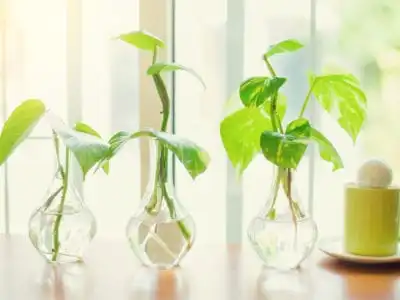“Lemon Lime Philodendron” typically refers to a specific cultivar of Philodendron, a popular group of tropical plants often grown as houseplants. The type of Philodendron is not known for extensive variegation like other philodendron or pothos varieties. Instead, its color variation is primarily due to the lemon-lime hue of young leaves. Moreover, if ingested, philodendrons, including the Lemon Lime variety, are toxic to pets and humans. However, If you want a Philodendron, consider looking for it at local nurseries or online plant shops.

Difference between neon pothos and lemon-lime philodendron
The two plants share some similarities but have unique characteristics that separate them. Here’s a comparison between Neon Pothos[1]Learn more about Neon Pothos. Read and Lemon Lime Philodendron:
| Basic Contrast features | Neon Pothos | Lemon Lime Philodendron |
| Scientific Name | Epipremnum aureum ‘Neon’ | Philodendron hederaceum var. hederaceum ‘Lemon Lime’ |
| Leaf Color | Bright neon green with marbled variegation | Bright green with lemon-lime hue when young, maturing to solid green |
| Leaf Shape | Heart-shaped | Heart-shaped |
| Growth Habit | Trailing vining plant | Trailing vining plant |
| Light Tolerance | Tolerates low to moderate indirect light | Prefers bright, indirect light |
| Humidity Preference | Can tolerate a range of humidity levels | Prefers higher humidity levels |
| Toxicity | Toxic to pets if ingested | Toxic to pets if chewed |

Read: Pothos vs Philodendron: A Head-to-Head Comparison
The Lemon Lime Philodendron and the Neon Pothos are colorful and relatively easy-to-care-for houseplants that can brighten indoor spaces. However, regarding leaf color and growth habits, the choice between them can be a matter of personal preference. Both plants offer similar care requirements, such as watering, lighting, and humidity needs.
Philodendron toxic to cats
The Lemon Lime Philodendron (Philodendron hederaceum var. hederaceum ‘Lemon Lime’) is toxic to cats. However, upon ingestion by pets, this philodendron variety contains compounds that can be harmful. If the leaves or stems of the plant are swallowed, calcium oxalate crystals in the plant may cause irritation and discomfort. However, keeping toxic plants out of cats’ reach ensures their safety if you have them in your home.
Read: ZZ Plant Toxicity to Cats: A Must-Know Guide

Lemon-lime philodendron plant calendar throughout the year
Here’s a general care calendar for your Philodendron hederaceum var. hederaceum ‘Lemon Lime’ throughout the year.
March to May (Spring Season):
- Light ⇒ As the days get longer, ensure your plant receives bright, indirect sunlight. Avoid direct exposure to daylight as it can affect overall plant growth and leaves.
- Watering ⇒ Spring growth may increase watering frequency. Water when the top one inch of soil is dry; do not let water settle down at the bottom.
- Fertilization ⇒ Begin or increase fertilizing with a balanced, every 4-6 weeks.
- Pruning ⇒ Trim to a manageable size according to your preference.
June to August (Hot Summer days):
- Light ⇒ Consider moving the plant slightly away from the intense peak time of sunlight.
- Watering ⇒ Monitor soil moisture closely in warmer months. Water more frequently if needed, but always allow excess water to drain.
- Humidity With higher temperatures, consider increasing humidity levels through misting or using a humidity tray.
- Fertilization ⇒ Fertilize every 4-6 weeks, but avoid over-fertilizing, which can lead to salt buildup.
September to November (Fall/winter days):
- Watering ⇒ As temperatures drop, reduce watering frequency. It is recommended that the top inch of soil be allowed to dry before watering.
December to February (Harsh winter days):
- Light ⇒ Avoid exposing the plant to sudden temperature fluctuations.
- Watering ⇒ Reduce watering further, allowing the top 1-2 inches of soil to dry before watering.
- Humidity ⇒ Maintain humidity around the plant to about 50 % through methods like misting or placing a tray filled with water to maintain the indoor plant humidity.

Throughout the year:
- Investigate for pests like spider mites and aphids. If you notice any infestations on the leaves or stems of your plants, you should take action.
- Spring and summer are the best times to repot plants that become root-bound or have outgrown their pot.
- If you want your plant to climb, provide a support structure like a trellis, stake, or moss pole.
Leaf Appearance and Features of Lemon-lime Philodendron
The Lemon Lime Philodendron’s foliage is what makes it a sought-after houseplant. The bright coloration of the young leaves and the heart-shaped form contribute to its visual appeal, making it an attractive addition to home decor. Therefore, the Lemon Lime Philodendron is known for its vibrant and striking foliage. Here are the key features and characteristics of its leaves:
Leaf Shape ⇒ The leaves of the Lemon Lime Philodendron are heart-shaped with bright chartreuse hues, with a slightly elongated tip. The overall leaf shape is symmetrical and pleasing to the eye. However, excessive watering can lead to the loss of its vibrant green color.
Leaf Color ⇒ The unique feature of this Philodendron is its bright and distinctive coloration. Philodendron Lemon Lime displays a lemon-lime hue, which gives the plant its name. However, as the leaves mature, they may become more solid green.
Leaf Texture ⇒ The leaves have a glossy or semi-glossy texture, adding to their visual appeal and making them stand out in indoor interiors.
Leaf Size ⇒ The size of the leaves can vary, but they are typically medium-sized. As the plant grows, the leaves can become larger.
Trailing Growth ⇒ The Lemon Lime Philodendron has a vining growth habit, which means the stems can grow long and trail down from hangings. The trailing growth can add a cascading and decorative element to your indoor interior area.

Philodendrons are Environment Friendly.
Lemon Lime Philodendron (Philodendron hederaceum var. hederaceum ‘Lemon Lime’) is considered environmentally friendly when grown and cared for responsibly. Here are some reasons why this plant can be regarded as environmentally friendly:
Air Purification
If you’re specifically looking for houseplants with strong air-purifying properties, consider lemon lime Philodendron, which has been scientifically studied for its effectiveness in removing indoor pollutants. In some cases, this plant is used to tackle the problem of formaldehyde in indoor spaces. This technology is particularly effective for removing formaldehyde from paint, roofing materials, and adhesives[2]Korostenskij, I., Propagation, upkeep, and impact on mental health and classroom/workplace success of Dracaena trifasciata, Chlorophytum comosum, and Philodendron hederaceum. 2021. Read.
Lemon Lime Philodendrons are like many other houseplants that can boost indoor air quality by absorbing pollutants. A healthier environment can be achieved through this method. Moreover, being environmentally friendly involves making conscious choices and continually striving to reduce your ecological footprint. Incorporating houseplants like the Lemon Lime Philodendron can be part of a broader effort to live more sustainably and mindfully.
The aesthetic appeal of indoor plants can contribute to a more natural and pleasing living space. Therefore, You’re enhancing your environment with natural beauty by choosing plants like the Lemon Lime Philodendron.
Read: Philodendron erubescens – Characteristics, Toxicity, and Benefits
Maintaining Optimal Variegation in Philodendron hederaceum var. hederaceum ‘Lemon Lime’
It is important to provide the right conditions and care to ensure the development and preservation of the distinctive leaf color of a Lemon Lime Philodendron. However, here are some tips to help you achieve and maintain the best variegation in your plant:
Light
Variegated plants generally need more light than their fully green counterparts to maintain their coloration. Place your Lemon Lime Philodendron in bright, indirect light, as injustice can fade the variegation. The plant might produce green leaves if it receives sufficient light.
However, try to maintain consistent lighting conditions. Move the plant around frequently so the light exposure does not fluctuate too much and does not affect the variegation of the foliage. It is a sign that the plant needs more light if the variegation fades or new leaves form predominantly green.
Watering And Humidity level
Water your plant when the top 1 inch of the soil seems dry. Overwatering can lead to root rot, affecting the plant’s overall health and variegation. In contrast, Like many tropical plants, Lemon Lime Philodendrons appreciate higher humidity levels. Maintaining higher humidity can help prevent stress on the plant, which can negatively impact its variegation. Therefore, Lemon Lime Philodendrons appreciate higher humidity levels. If your indoor environment is dry, consider placing a water tray near the plant to balance the plant humidity level or misting the leaves regularly.
Read: Banana water and peels for plants growth
Temperature
Maintain average room temperatures between 65-75°F (18-24°C). Temperature fluctuations should not be introduced to the plant suddenly.
Watch for pests that can stress the plant and affect its coloration. Be on the lookout for signs of infestation on the leaves and stems regularly. However, some color variations can be expected, even within the same plant. Not all leaves may display the same level of variegation, and that’s okay.
Growth Tips For lemon lime philodendron
Indeed, here are some growth tips to help your Lemon Lime Philodendron (Philodendron hederaceum var. hederaceum ‘Lemon Lime’) thrive and flourish:
Rotate Orientation
To ensure even growth, periodically rotate the plant to give all sides access to light. This will provide even coloration to the leaves.
However, by providing the right conditions, consistent care, and monitoring your plant’s growth, you can help your Lemon Lime Philodendron thrive and showcase its vibrant foliage.
Lemon Lime philodendron propagation method by considering the hardiness zone for indoor and outdoor areas
Lemon Lime Philodendron can be propagated through stem cuttings using water and soil. However, since this plant is typically grown indoors and is sensitive to cold, propagation for outdoor planting might not be practical in most regions.
Read: The Ecological role of Conifers in forests and Wildlife Habitats
Here are the steps for propagating Philodendron indoors using water and soil methods:
Propagation in Water:
- Select a Cutting: Choose a healthy stem cutting with a few nodes ( A node is a point where leaves and roots develop). However, cut just 1 inch below a node.
- Remove Lower Leaves: Trim the cutting to have 1-2 nodes. Remove any leaves near the bottom nodes.
- Place in Water: Place the cutting in a water container, submerging the nodes while the leaves are above water. Use a clear container to monitor root growth.
- Root Development: Keep the container in a bright, indirect light location. Therefore, to prevent stagnation and promote root growth, replace the water every few days.
- Transplanting: Once roots are a few inches long, you can transplant the cutting into a well-draining potting mix.
Propagation in Soil:

Hardiness Zones:
Because Lemon Lime Philodendrons tend to be grown indoors, they are unsuitable for planting outdoors in most regions because of their sensitivity to cold temperatures. It’s best to propagate and ensure the plant has the appropriate environment by keeping it indoors.[3] Plant Hardiness zone for Indoor Plants. Read
Choosing philodendron species that are suitable for your hardiness zone and climate is essential when planting philodendrons outside. This is not the case with Lemon Lime Philodendrons. Always research and choose plants that are well-adapted to your local conditions.
Read about: Kalanchoe Daigremontiana (Mother of Thousands)
Concluding Here
The Lemon Lime Philodendron thrives with bright, indirect light, moderate watering, and humidity. Avoid direct sun and severe cold conditions. Regular pruning maintains its appealing form. However, this indoor plant enhances aesthetics and air quality. With care, it’s a captivating addition to any interior area.
References
| ↑1 | Learn more about Neon Pothos. Read |
|---|---|
| ↑2 | Korostenskij, I., Propagation, upkeep, and impact on mental health and classroom/workplace success of Dracaena trifasciata, Chlorophytum comosum, and Philodendron hederaceum. 2021. Read |
| ↑3 | Plant Hardiness zone for Indoor Plants. Read |



